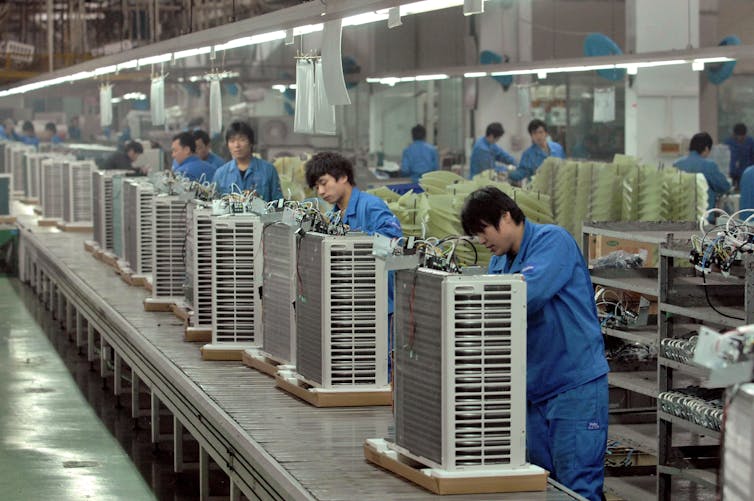‘Doom loops’ are accelerating climate change – but we can break them

Vicious cycles are accelerating climate change. One is happening at the north pole, where rising temperatures caused by record levels of fossil fuel combustion are melting more and more sea ice.
Indeed, the extent of Arctic winter sea ice in March 2025 was the lowest ever recorded. This decline in sea ice means the Earth reflects less of the Sun’s energy back into space. So, more climate change leads to less sea ice – and more climate change.
Human behaviour is not immune to this dynamic either, according to a recent report by the International Energy Agency (IEA). It identified another troubling feedback loop: demand for coal rose 1% globally in 2024 off the back of intense heatwaves in China and India, which spurred a frenzy for air-conditioners and excess fuel to power them.
The need to cool ourselves, and briefly escape the consequences of climate change, is driving more climate change. Thankfully, there are ways to break these cycles and form greener habits. Today, we’ll look at one in particular.
The Sun can cool you down
“As the climate crisis deepens, close to half of the world’s people have little defence against deadly heat,” says Radhika Khosla, an associate professor of urban sustainability at the University of Oxford.
“At the same time, energy demand from cooling – by those who can afford it – could more than double by 2050.”
If wealthy countries paid the enormous climate finance debt they owe the developing world, it could help finance the closing of this gap. And thankfully, advancements in renewable energy technology mean no one should need to contribute to a spike in fossil fuel use just to keep cool.
“The absurdity of resorting to coal to power air conditioners … is difficult to miss”, say a team of engineers and energy experts at Nottingham Trent University and Coventry University, led by Tom Rogers. They recommend rooftop solar panels instead, which can soak up sunshine during heatwaves and turn it into electricity for air-conditioning units.
 Chinese workers assemble air conditioners on a production line in Shandong province, eastern China. EPA/Wang Jun
Chinese workers assemble air conditioners on a production line in Shandong province, eastern China. EPA/Wang Jun“Rooftop solar can also reduce demand for cooling by keeping buildings in the shade,” the team say. “A study conducted by Arizona State University found that even a modest group of solar panels that shade about half a roof can lead to anything from 2% to 13% reduction in cooling demand, depending on factors such as location, roof type and insulation levels.”
Read more: Rising temperatures mean more air conditioning which means more electricity is needed – rooftop solar is a perfect fit
Of course, solar panels are less helpful for powering air conditioners in the evening, when lots of people turn them on after work or school.
“Researchers in Australia have proposed a clever solution to address this imbalance, by programming air-conditioning units to work in tandem with solar systems to pre-cool buildings before people arrive home,” Rogers and his colleagues add.
There is huge untapped potential for generating electricity from rooftop solar – even in the dreary UK. It could ensure that future heatwaves are a boon for solar energy, not coal power.
“Consider the possibilities for Nottingham and Coventry, two cities in England’s Midlands where we work,” they say.
“If Nottingham were to maximise its rooftop potential, all those panels could generate nearly 500 megawatts (MW) of electricity, about the same as a medium-sized gas power plant. Coventry has greater potential, with 700MW.
"These capacities would equate to nearly one-third of Nottingham’s electricity demand and almost half of Coventry’s – from their rooftops alone.”
Doom loops
Installing solar panels on top of buildings worldwide will need massive investment in equipment and training. It will require new means of incentivising the uptake of this technology and, as mentioned earlier, the redistribution of wealth to allow low-emitting but highly vulnerable nations to make the switch.
But there are likely to be virtuous cycles as well as vicious ones. Once a certain threshold has been crossed, like the price and capacity of batteries or the number of homes with heat pumps installed, “a domino effect of rapid changes” takes effect such that green alternatives swiftly become the established norm.
However, the prospect of harmonising these efforts across borders butts against a trend moving in the opposite direction. As the world warms, relations between nations are becoming more fraught and war, trade tensions and internal strife are obscuring the universal threat of climate change.
 A Trump yard sign during the 2024 election campaign. Dlbillings_Photography/Shutterstock
A Trump yard sign during the 2024 election campaign. Dlbillings_Photography/ShutterstockClimate risk expert Laurie Laybourn and earth system scientist James Dyke, both at the University of Exeter, say that extreme weather in 2022 caused crop failures that made food more expensive and stoked headline inflation rates. Climate-sceptic Donald Trump made hay with these high prices in the 2024 US election.
“The risk is that this ‘doom loop’ runs faster and faster and ultimately derails our ability to phase out fossil fuels fast enough to avoid the worst climate consequences,” they say.
Read more: A 'doom loop' of climate change and geopolitical instability is beginning
However, Laybourn and Dyke are not wholly pessimistic. History shows that periods of instability and crisis like the one we are living through also provide fertile ground for positive change, they argue, and the chance to accelerate virtuous circles.
“For example, out of the crises of the interwar period and the devastation of the second world war came legal protections for human rights, universal welfare systems and decolonisation.”
댓글
댓글 쓰기